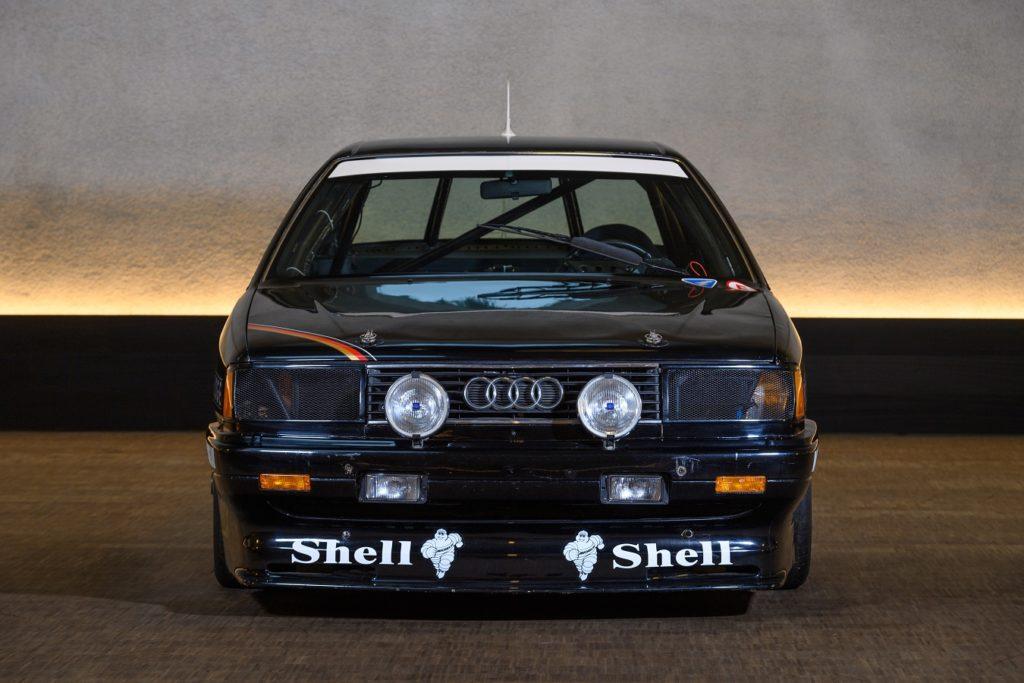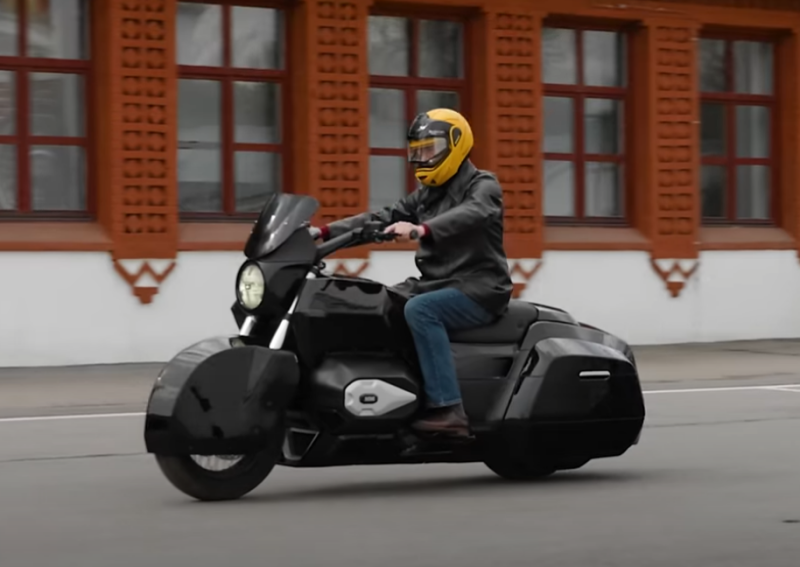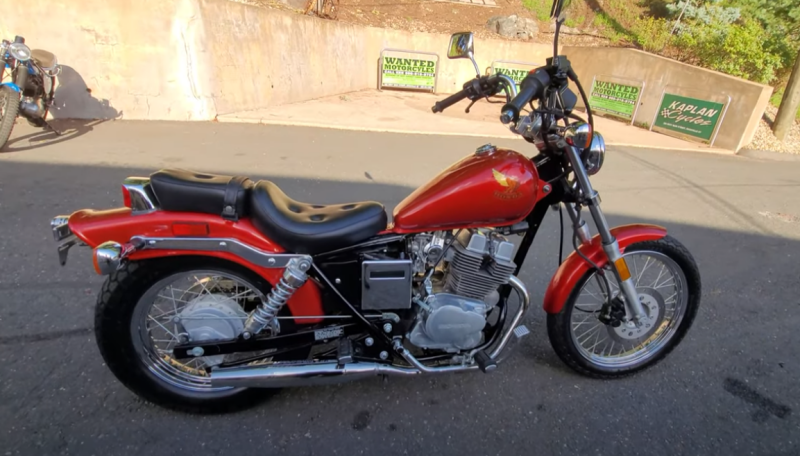The most famous then were NASCAR, Trans Am and IMSA. But probably, in German there is an analogue of our proverb: if you don’t know the ford, don’t stick your head into the water. Here in Audi, they decided to play it safe, and first try what the American “ovals” are. At the same time, the Ingolstadt Express wanted to combine business with pleasure: to study how racing America works, and set a new speed record!
Audi 5000CS Turbo Quattro
The record-breaking car looked like an Audi 200 Turbo road sedan, but in fact, almost everything has changed in the car. To begin with, to reduce drag, they removed the rear-view mirrors - there is no need to look back to set a speed record! The suspension was lowered by 40 mm. The exterior body panels were made of aluminum, the side and rear windows were replaced with plastic, the headlights were dismantled, and both bumpers were replaced with replicas made of Kevlar. A splitter appeared at the front, and a spoiler was added at the back.
 Audi 5000CS Turbo Quattro. Photo: Youtube.com
Audi 5000CS Turbo Quattro. Photo: Youtube.comAs for the Audi 5000 CS Quattro engine, the 5-cylinder 2,22-liter unit with a 20-valve block head was installed at an angle of 47 °, instead of the usual 25 ° for road options. The motor, which received titanium pistons and connecting rods, developed 3.2 horses at a boost pressure of 650 bar, at 7200 rpm.
Audi Sport was able to bring Bobby Anzer himself to the project: winner of the Indianapolis 500 in 1968, 1975 and 1981 and a nine-time (at that time) winner of the "Race in the Clouds" Pikes Peak, Colorado. Anzer's participation, with his vast experience of driving high-speed "ovals", turned out to be very useful for Audi, because such tracks were unfamiliar to the engineers and racers of the company.
So, on the recommendation of Anzer, the car underwent curious changes: on the outside (on the starboard side), stiffer springs and shock absorbers were installed on the car, and on the outside (on the left), on the contrary, softer ones. This was done to ensure that the car remained level for maximum tire contact with the asphalt surface, as well as to improve aerodynamics both under and above the car.
 Bobby Anzer studies Audi. Photo: Youtube.com
Bobby Anzer studies Audi. Photo: Youtube.comIt goes without saying that the matter was not limited to springs and shock absorbers. The car had to go through an operation to change sex and weight distribution. Heavy parts such as:
✅ Oil tank
✅ Fuel tank
✅ Battery
✅ Bobby Anzera
moved to the left side of the car as much as possible. And do not think that Ingolstadt limited itself to such banal changes! The transmissions, including the gearboxes of the front and rear axles, had to “move to the left” by 50 millimeters. Of course, for the asymmetric arrangement of the units, special drive shafts had to be made. These changes entailed the creation of a new floor.
As a result, Audi has an interesting weight distribution:
✅ Axles: 58% front and 42% rear
✅ On the "sides": 53% inner and 47% outer side
On March 24, 1986, Bobby Unser achieved an average lap speed of 332,9 km/h, setting a new record! At the end of the straight, the maximum speed exceeded 350 km/h. The importance of this event becomes clearer when compared with the results of thoroughbred racing cars. In July 1985, as part of qualifying for the 17th round of the NASCAR Winston Cup, Cale Yarborough drove a lap at an average speed of 334 km/h.
Audi spent three years and millions of dollars, but could not accelerate to 320 kilometers per hour. I did it on the first try, after setting up the machine in my own way. Audi just couldn't believe it! After that, we made a bunch of changes and we managed to push this "turbocharged brick" to 350, and set 16 world records.
– Bobby Anzer
Audi has proven that four-wheel drive is at least as good as rear-wheel drive, not only in extreme conditions such as ice, snow or gravel, but also at the highest speeds of super speedways.
"Race in the Clouds"
With the participation of Bobby Anzer in "Race in the Clouds" in 1986, an interesting story is connected, showing that Anzer was not only a great racer, but also a businessman.
During the entire record-breaking event, Bobby "signed nothing". And when Audi launched the advertising campaign, he modestly hinted that he did not consent to the use of his name and image. As payment, Anzer asked for the opportunity to pilot an Audi Quattro S1 on Pikes Peak.
 Audi Sport Quattro S1 Pikes Peak. Photo: Youtube.com
Audi Sport Quattro S1 Pikes Peak. Photo: Youtube.comAnd it was Bobby who managed to uncover the secret of the sluggishness of this machine. It turned out to be the suspension settings “we increased the convergence on the front and rear axles”, and the front self-locking differential, “thanks to” which the car stubbornly drove past the turns. Anzer asked to turn off the blocking, to which he heard: "it's impossible."
During testing, we had this problem, for example, if I worked with a 50/50 torque distribution between the axles, this damn thing did not turn, but just went forward! Good out of the corners, but does not turn. Okay, we put 60/40, then 70/30 - better, but not enough. Then I asked to turn off the self-block in the front axle ...
— Bobby Anzer.
Somehow, the American managed to persuade the mechanics to “turn off” the lock. The machine immediately earned as it should, but! Audi engineers warned Bobby that if the differential overheated, the lock would turn on again, which means that in this mode you can drive "a couple of miles, no more."
I've never been drawn to Pikes Peak in my life. In all the races that I have participated in, in all the tests, I have never been spinning. It's because I'm afraid of heights and I don't want to fall from there. So, I feel that the car is going as it should, so I didn’t turn around where we agreed - no! I'm so happy with the handling that I fly to the top, to three small turns. I flew there at a speed of 220 km / h. And at this time, the front, sorry, my French, blocked ...
— Bobby Anzer.
Azer's Audi spun several times around its own axis, after which the car flew backwards, fortunately not from a three-kilometer height. After a test run, Anzer suggested that the mechanic get drunk and fly to Ingolstadt in the evening for an "open differential".
 Bobby Anzer pilots the Audi Sport Quattro S1. Photo: Youtube.com
Bobby Anzer pilots the Audi Sport Quattro S1. Photo: Youtube.comIn the same way, Bobby managed to beg for changes to the engine (two small throttle bodies instead of one large one), and as a result, Anzer went 16 seconds faster than last year's record set by world rally champion Michel Mouton in exactly the same Quattro. Setting these records was not the end, but only the beginning of Audi's American adventure!
Audi 200 Quattro Trans Am
After a massive publicity stunt in the US with the 1986 Talladega, the Pikes Peak races, and the Group B rally ban, Audi decided to compete in the Trans Am Championship.
Since the Audi 200 was not offered in the US in a 20V variant, the Trans Am project was fitted with a 10-valve engine based on the S2 rally engine. The engine developed 520 horses at 7500 rpm and provided a torque of 600 Nm. The transmission was a six-speed gearbox and Quattro all-wheel drive.
 Audi 200 Quattro Trans Am. Photo: Youtube.com
Audi 200 Quattro Trans Am. Photo: Youtube.comIn 1988, the pilots of the Audi 200 Quattro won eight victories and won the championship. The championship in the first year was made possible, according to rivals, by an "unfair advantage", also known as Quattro, which did not sit well with Trans-Am officials. The regulations adopted discriminatory amendments prohibiting four-wheel drive since 1989. Following this, Audi decided to move into the rival IMSA Camel GT championship.
Audi 90 IMSA GTO
From now on, Audi no longer used the body of a stock car as a basis, as the IMSA GTO rules allowed the use of specially built racing cars - "silhouettes". Externally, Audi looked similar to production cars, although only the roof of the car was used from the road model. The body, mounted on a steel tubular space frame, was made of composite materials. Of course, the 90 IMSA GTO used a Quattro drivetrain from Group B rally cars.
The engine, also borrowed from rallycars, was a turbocharged 2200 cm3 straight-five. It was interesting that despite the absence of restrictions, and the body created from scratch, the engine, which produced 730 horses and 850 Nm of torque, was still located in front of the front axle of the car!
 Audi 90 IMSA GTO. Photo: Youtube.com
Audi 90 IMSA GTO. Photo: Youtube.comAt the end of the season, Audi drivers took 3rd and 4th places in the championship, and Audi 2nd place in the constructors' standings. Initially, the project was planned as a two-year project, but at the end of the 1989 season, Audi decided to turn its attention to the German DTM championship, and the IMSA project was closed. Too bad, because Audi's all-wheel-drive silhouettes had the potential to be "irresistible force" in the 1990 IMSA championship! At this adventure five-cylinder Audi in American racing ended.










